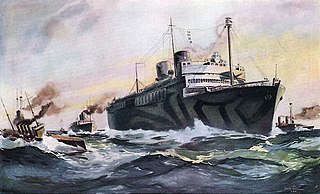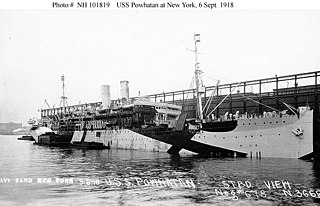
USS Culgoa (AF-3) was a refrigerated supply ship in the United States Navy.

USS Susquehanna (ID-3016) was a transport for the United States Navy during World War I. She was the second U.S. Navy ship to be named for the Susquehanna River. Before the war she operated at SS Rhein, an ocean liner for North German Lloyd. She was the lead ship of her class of three ocean liners. After the end of World War I, the ship operated briefly in passenger service as SS Susquehanna. Laid up in 1922, Susquehanna was sold to Japanese ship breakers in 1928 and scrapped.

USS Freedom (ID-3024) was a cargo and transport ship in the United States Navy during World War I. Originally SS Wittekind for the North German Lloyd line, the ship also served as USAT Iroquois and USAT Freedom after being seized by the United States in 1917.

USS Pocahontas (SP-3044) was a transport ship for the United States Navy during World War I. She was originally SS Prinzess Irene, a Barbarossa-class ocean liner built in 1899 by AG Vulcan Stettin of Stettin, Germany, for the North German Lloyd line.

USS Siboney (ID-2999) was a United States Navy troopship in World War I. She was the sister ship of USS Orizaba (ID-1536). Launched as SS Oriente, she was soon renamed after Siboney, Cuba, a landing site of United States forces during the Spanish–American War. After her navy service ended, she was SS Siboney for the New York & Cuba Mail Steamship Co.. The ship was operated under charter by American Export Lines beginning in late 1940. During World War II she served the U.S. Army as transport USAT Siboney and as hospital ship USAHS Charles A. Stafford.

USS DeKalb (ID-3010) was the German mail ship Prinz Eitel Friedrich that served during the early part of the First World War as an auxiliary cruiser (Hilfkreuzer) in the Imperial German Navy and later after the US entry into the war, as a US Navy troop ship. Post war she returned to civilian service as the US transatlantic liner SS Mount Clay.

USS Celtic (AF-2) was a Celtic-class stores ship acquired by the U.S. Navy for use in the Spanish–American War. She served again during World War I in the dangerous North Atlantic Ocean, delivering general goods and ammunition to American Expeditionary Force troops in Europe.

USS Aeolus (ID-3005), sometimes also spelled Æolus, was a United States Navy transport ship during World War I. She was formerly the North German Lloyd liner SS Grosser Kurfürst, also spelled Großer Kurfürst, launched in 1899 that sailed regularly between Bremen and New York. At the outset of World War I the ship was interned by the United States and, when the U.S. entered the conflict in 1917, was seized and converted to a troop transport.

USS Antigone (ID-3007) was a transport for the United States Navy during World War I, and the first ship of that name for the U.S. Navy. She was originally SS Neckar for North German Lloyd from her 1900 launch until seized by the U.S. in 1917. After her war service she was SS Potomac for United States Lines.

SS Prinz Friedrich Wilhelm was an ocean liner for North German Lloyd (NDL) from her launch in 1907 until the end of World War I. After the war, she briefly served as USS Prinz Friedrich Wilhelm (ID-4063) for the United States Navy returning American troops from France. The vessel was first chartered—and later purchased outright—by Canadian Pacific Steamships (CP) and operated under the names Empress of China, Empress of India, Montlaurier, Monteith, and Montnairn. She was scrapped in 1929.

USS Powhatan (ID–3013) was a transport ship for the United States Navy during World War I. She was originally Hamburg, a Barbarossa-class ocean liner built in 1899 by AG Vulkan of Stettin, Germany, for the Hamburg America Line. At the outset of World War I the ship was interned by the United States.

USS Santa Clara (ID-4523) was a Santa Cecilia-class freighter for the United States Navy during World War I. In service for the United States Army she was known as USAT Santa Clara. Both before and after her World War I service she was known as SS Santa Clara for the Grace Line.

USS Edgar F. Luckenbach (ID-4597) was a cargo ship and troop transport that served in the United States Navy from 1918 to 1919.

SS Edward Luckenbach was the first of five new cargo ships to be built for the Luckenbach Steamship Company by Fore River Shipbuilding Corporation. The ship was launched in September 1916, delivered in November and briefly operated as such before being requisitioned for World War I service. The ship was one of the cargo vessels in the first large convoy transporting U.S. Army forces to France. After that convoy the ship served as a U.S. Army Chartered Transport (USACT) until converted by the Army to a troop ship and turned over to the Navy a few months before the war's end. The Navy commissioned the ship as USS Edward Luckenbach assigning the miscellaneous identification number ID-1662 in August 1918. The transport made one wartime voyage with continued voyages returning the Army to the U.S. until August 1919.

USS F. J. Luckenbach (ID-2160) was a cargo ship and troop transport that served in the United States Navy from 1918 to 1919. SS F. J. Luckenbach was built as a commercial cargo ship at Quincy, Massachusetts, by Fore River Shipbuilding Corporation for Luckenbach Steamship Company of New York City. Launched on 15 September 1917, she was delivered to Luckenbach on 28 November 1917. She then came under the control of the United States Shipping Board. The Shipping Board transferred her to the U.S. Navy for World War I service on 9 January 1918. Assigned Identification Number 2160, she was commissioned the same day as USS F. J. Luckenbach.

USS Julia Luckenbach (ID-2407) was a cargo ship and troop transport that served in the United States Navy from 1918 to 1919.

USS Suwanee (ID-1320) was a United States Navy transport in commission in 1919. She was the second ship to carry her name.

USS Mexican (ID-1655) was a United States Navy cargo ship and animal transport in commission from 1917 to 1919. She operated as the commercial steamship SS Mexican from 1907 to 1917 and from 1919 to 1948.

USS Dreadnaught (ID-1951), later YT-534 and YNG-21, was a United States Navy tug that was in service from 1918 to 1944.

SS Tivives was a United Fruit Company passenger and refrigerated fruit cargo ship built 1911 by Workman, Clark & Company, Ltd. in Belfast. The ship was launched 1 August 1911 as Peralta but renamed before completion. As a foreign built vessel operating for a company in the United States the ship was British flagged. With outbreak of war in Europe in 1914 the ship, as did all British registered company ships, changed flag to the United States. Between 5 July 1918 and 25 April 1919 the ship was chartered and commissioned by the United States Navy for operation as USS Tivives





















